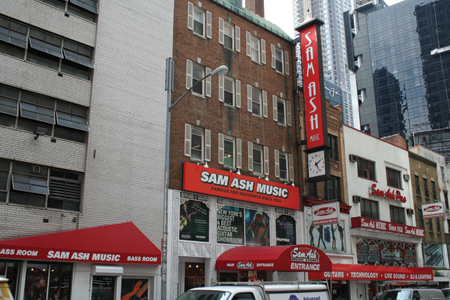The music industry, perhaps more than any other, has a history that is storied, colorful and worth preserving. So, when the folks in this industry mark the end of an era, it truly means something. On July 24, the New York Post reported on Sam Ash’s plans to shutter its multiple stores on New York City’s West 48th Street—the strip historically known as “Music Row”—and open an expansive, 30,000-square-foot superstore on West 34th Street, bringing together what had been, at the 48th Street location, a rather disjointed collection of storefronts on either side of the street. The Retailer spoke to Richard Ash, Sam Ash CEO, to get the details on the new location, as well as to reflect on Music Row’s glory days.
Sam Ash, founded in 1924, is an iconic name in music products, earning its designation as the U.S.’ largest family-owned chain of musical instrument stores. So, having grown up completely immersed in a music culture, Richard Ash is intimately familiar with Music Row during its prime. He actually managed the Ash stores on the block for more than eight years back in the ’80s. “It was a mecca for musicians all over the world back in those days,” Ash said. “There was We Buy Guitars, Terminal Music, Alex Music, Silver and Horland, Sam Ash, Manny’s Music and more.” Most of them were small stores of perhaps 2,000 or 3,000 square feet, housed in decades-old buildings, some of whose basements are the bedrock of Manhattan. Ash reminisced, “The Beatles went to 48th Street. Eric Clapton bought his first wah-wah pedal at Manny’s Music. Jimi Hendrix used to have his Stratocaster shipped from there. Rock stars from all over the world went there.” And, largely, Ash said, this was because, at that time, music stores were not ubiquitous as they are now; if you lived in Connecticut, New Jersey, upstate New York or the city suburbs and wanted musical instruments, the place to go was 48th Street.
However, Ash said, what was once Music Row really went away 15 years ago. As music retailers pushed out into the suburbs, 48th Street was a mecca no more and, as a result, the vast majority of the stores closed over the years, leaving solitary survivors like Rudy’s Music Stop and, of course, the numerous Sam Ash stores. “We purchased most of the retail stores on the block,” Ash explained, “which is very awkward, because the stores weren’t even connected.” As a result, prior to this planned move, Ash had to contend with having a handful of stores on either side of the street with different entrances and different levels. “We had eight different basements and second-floor stockrooms in five different locations,” he continued. “We’d be running up two or three flights of stairs to get drumsticks, because there are no elevators in most of these buildings.” He described operations as being “a bear,” which underscores how sensible the move is.
The move to 333 West 34th Street, which we expect to occur in the first quarter of 2013, will create the kind of huge musical instrument retail space that typifies Sam Ash outlets. And, for the consolidated location, which will comprise one sales level, one could not pick a better street than 34th, which boasts transportation hubs Penn Station, the Midtown tunnel and the Lincoln tunnel, as well as the iconic Macy’s Herald Square—the world’s largest—store and much more. Ash’s enthusiasm about the move was evident in his voice as he enumerated the benefits.
In simple terms, as Ash noted, “We’re just moving out of eight ratty, discombobulated, poorly connected retail spaces and are going to one larger space that’s contiguous and in a much better location.” But, at the same time—and even granting that, for the last 15 years or so, there hasn’t really been a Music Row but, rather, a Sam Ash Row—one can’t help but be a little melancholy at the closing of this chapter of music history.



